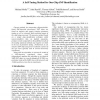Free Online Productivity Tools
i2Speak
i2Symbol
i2OCR
iTex2Img
iWeb2Print
iWeb2Shot
i2Type
iPdf2Split
iPdf2Merge
i2Bopomofo
i2Arabic
i2Style
i2Image
i2PDF
iLatex2Rtf
Sci2ools
CSB
2004
IEEE
2004
IEEE
A Self-Tuning Method for One-Chip SNP Identification
Current methods for interpreting oligonucleotidebased SNP-detection microarrays, SNP chips, are based on statistics and require extensive parameter tuning as well as extremely high-resolution images of the chip being processed. We present a method, based on a simple data-classification technique called nearest-neighbors that, on haploid organisms, produces results comparable to the published results of the leading statistical methods and requires very little in the way of parameter tuning. Furthermore, it can interpret SNP chips using lower-resolution scanners of the type more typically used in current microarray experiments. Along with our algorithm, we present the results of a SNP-detection experiment where, when independently applying this algorithm to six identical SARS SNP chips, we correctly identify all 24 SNPs in a particular strain of the SARS virus, with between 6 and 13 false positives across the six experiments.
| Added | 20 Aug 2010 |
| Updated | 20 Aug 2010 |
| Type | Conference |
| Year | 2004 |
| Where | CSB |
| Authors | Michael Molla, Jude W. Shavlik, Thomas Albert, Todd Richmond, Steven Smith |
Comments (0)

